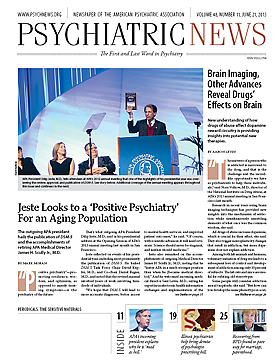“The universe of a person who is addicted is narrowed to the drug, and that is the challenge and the incredible opportunity we have as psychiatrists to help these individuals,” said Nora Volkow, M.D., director of the National Institute on Drug Abuse, at APA’s 2013 annual meeting in San Francisco last month.
Research in recent years using brain imaging techniques has provided new insights into the mechanism of addiction while simultaneously unsettling elements of what once was the common wisdom, she said.
All drugs of abuse increase dopamine, which is crucial for their effect, she said. They also trigger neuroplasticity changes that result in addiction, but more dopamine does not explain addiction.
Among both lab animals and humans, voluntary initiation of drug use leads to a subsequent loss of control and development of addiction among about 10 percent of subjects. The lab rats and mice are useful for refuting old stereotypes.
Some people still consider addiction moral turpitude, she said. “But how can you develop the same phenotype in a rat, which has no moral precepts?”
Other ideas about addiction have also changed in recent years, she said. Once it was thought that addicts were overly sensitive to dopaminergic effects, but now it appears that they have an attenuated response in the dopamine system to drug consumption.
Repeated drug use leads to less D2 receptor pathway signaling, inhibiting sensitivity to reward, she said.
This makes evolutionary sense as the reward value of dopamine signaling shifts from consumption of drugs or food to expectation and stimulus.
“As in addiction, it motivates your behavior to get that reward,” she said. “Once consumed, it doesn’t matter. You don’t need to motivate behavior then.”
For example, simply showing videos to addicts of people using cocaine releases dopamine in the striatum and provokes a desire for the drug. This may also explain why it is better for psychiatrists to help patients avoid settings where they risk taking drugs, rather than having to intervene once they have started using again.
Yet another discovery is that addiction is not solely a property of the limbic system but also involves the prefrontal cortex, said Volkow. D1 and D2 receptors there are important for normal executive function. However, D2 expression is lower during addiction to cocaine, methamphetamine, alcohol, heroin, and nicotine (but not marijuana). Reduced D2 receptor signaling in addiction decreases inhibitory control in the prefrontal area, letting up on the neural “brakes” on compulsive drug use.
“That’s why the process of addiction becomes so ingrained and why patients go to tremendous effort to get drugs at such a horrific price,” she said. Awareness of deficits in the prefrontal cortex can help psychiatrists treat addicted individuals using approaches that allow them to assert better self-control, extinguish conditioned responses to drugs, and enhance the value of alternative rewards.
A third insight has come from genetic studies of smoking. Three alleles for nicotine receptors—α5, α3, and β4—are heavily concentrated in the habenula, a region that has been targeted by deep brain stimulation for treatment of depression.
“That may be related to the antidepressant properties of smoking,” she speculated.
Nevertheless, no single area of the brain is implicated in addiction, she said. “Multiple circuits are disrupted as they are in other mental illnesses, like schizophrenia, ADHD, and mood disorders.”
Perhaps as a consequence, the treatment of addiction requires a multipronged approach to strengthen brain circuits that have been impaired by the use of drugs, she said. Thus, in addition to research into behavioral and medical treatments, NIDA also is funding a search for vaccines to produce antibodies that would bind to cocaine, heroin, methamphetamine, and other addictive substances in the bloodstream and prevent their entry into the brain.
“These are some of the most exciting areas of science in the field of drug addiction,” said Volkow. ■

